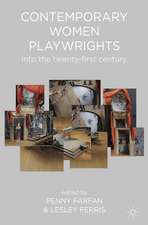Katherine Mansfield and the Bloomsbury Group
Editat de Professor Todd Martinen Limba Engleză Paperback – 23 ian 2019
| Toate formatele și edițiile | Preț | Express |
|---|---|---|
| Paperback (1) | 231.24 lei 6-8 săpt. | |
| Bloomsbury Publishing – 23 ian 2019 | 231.24 lei 6-8 săpt. | |
| Hardback (1) | 773.81 lei 6-8 săpt. | |
| Bloomsbury Publishing – 31 mai 2017 | 773.81 lei 6-8 săpt. |
Preț: 231.24 lei
Preț vechi: 297.31 lei
-22% Nou
Puncte Express: 347
Preț estimativ în valută:
44.25€ • 46.03$ • 36.53£
44.25€ • 46.03$ • 36.53£
Carte tipărită la comandă
Livrare economică 14-28 aprilie
Preluare comenzi: 021 569.72.76
Specificații
ISBN-13: 9781350094611
ISBN-10: 1350094617
Pagini: 264
Ilustrații: 1 b/w illustration
Dimensiuni: 156 x 234 x 19 mm
Greutate: 0.37 kg
Editura: Bloomsbury Publishing
Colecția Bloomsbury Academic
Locul publicării:London, United Kingdom
ISBN-10: 1350094617
Pagini: 264
Ilustrații: 1 b/w illustration
Dimensiuni: 156 x 234 x 19 mm
Greutate: 0.37 kg
Editura: Bloomsbury Publishing
Colecția Bloomsbury Academic
Locul publicării:London, United Kingdom
Caracteristici
Chapters cover Mansfield's relationships with Aldous Huxley, T.S. Eliot, Walter de la Mare and many other modernist artists
Notă biografică
Todd Martin is Professor of English at Huntington University, USA. He is Membership Secretary for the Katherine Mansfield Society and co-editor of Katherine Mansfield and World War One (2014), Katherine Mansfield and Translation (2015), and Katherine Mansfield and Psychology (2016).
Cuprins
1. Introduction, Todd Martin (Huntington University, USA)Part 1: Katherine Mansfield and Bloomsbury Friendships2. 'I Wonder if You Know What Your Visits Were to Me': Mansfield, Woolf, and Modernist Hospitality,Christine Darrohn (University of Maine, Farmington, USA)3. A Critical Duet: Mansfield and Woolf Reviewing Their Contemporaries, Sydney Janet Kaplan (University of Washington, USA)4. Katherine Mansfield and Aldous Huxley: A Blighted Friendship, Gerri Kimber (University of Northampton, UK)5. Katherine Mansfield and T.S. Eliot: A Literary Frisson, Janet Wilson (University of Northampton, UK)6. 'Memorials of the Dead': Walter de la Mare, Katherine Mansfield and the Literary Afterlife, Jenny McDonnell (Institute of Art, Design and Technology, Dun Laoghaire, Ireland)7. Mansfield and Dunning: An 'Important and Shadowy' Friendship, Erika Baldt (Burlington County College, USA)Part 2: Katherine Mansfield and Literary Bloomsbury8. Katherine Mansfield: A Fauvist, Colonial Outsider Encounters Bloomsbury, Mary Ann Gillies (Simon Fraser University, Canada)9. 'Wanted, a New Word' (World): Katherine Mansfield and the Athenaeum, Chris Mourant (King's College London, UK)10. Space of Debate, Debating Space: A Look at Irreverent Bloomsbury Through the Lens of Mansfield's Stories, Ruchi Mundeja (Delhi University, India)11. Performances of Knowledge in Mansfield's Bloomsbury Satires, Alex Moffett (Providence College, USA)12. Hungry Artists, W.L. George, and Why the 'Blooms Berries' Cannot Nourish, Ann Marshall (Independent Scholar)13. An Invitation to the Table: Katherine Mansfield's 'A Cup of Tea', Richard Cappuccio (Independent Scholar)BibliographyIndex
Recenzii
Katherine Mansfield: A Fauvist, Colonial Outsider Encounters Bloomsbury stood out in the volume for its clear articulation and solid theorization of the role played by Mansfield's colonial origins in her representations of perception. Gerri Kimber also argues compellingly for a reexamination of the relationship between Mansfield and Aldous Huxley in light of theirrepeated fictional representations of each other. Ruchi Mundeja's essay on Mansfield's critical representations of the imperial consumerism that underlay Bloomsbury's bohemian revisions of domestic space makes a strong contribution to the developing body of work on modernist domesticity.
For the most part, Mansfield's literary reputation has revolved around two things: her mastery of the modernist short story and her contentious relationship with Virginia Woolf (Woolf frequently-and unfortunately-tends to subsume Mansfield). As these essays point out, there is much more to say. The collection opens with an examination of the emotional and professional complexities of Mansfield and Woolf's relationship viewed via disparate notions of hospitality. This engaging essay serves as the springboard for an exploration of Mansfield and Bloomsbury: to be specific, part 1 looks at Mansfield and the peripheral figures of Bloomsbury (Aldous Huxley, T. S. Eliot, Walter de la Mare, Millar Dunning, and W. L. George), and part 2 looks at Mansfield as peripheral to Bloomsbury. Gems include essays on Mansfield's (and Woolf's) literary criticism that showcase the symbiosis between criticism and creativity. Including essays by both renowned Mansfield scholars and new voices in this field, this collection reiterates Bloomsbury's influence on the artistic growth and mentoring capabilities of one of the most important modernist writers of the 20th century. Summing Up: Highly recommended. Lower-division undergraduates through faculty; general readers.
Provide[s] rich new pickings for Mansfield scholars and Bloomsbury devotees alike.
An extremely helpful collection of articles on the mutual influence and interaction of Mansfield with the emerging artists from this turbulent period.
This wide-ranging collection of essays makes fresh forays into the interstices of well-travelled literary territory, escorting readers to familiar topoi like Bloomsbury and Garsington Manor to discover new insights through intimate portrayals of their inhabitants and visitors. Katherine Mansfield is both object of study and muse in this endeavor, providing satirical perspectives on the social groups and gatherings which so often made her feel like an outsider, and inspiring the imaginatively sympathetic prose of an outstanding group of scholars devoted to celebrating her work.
An inspiring and very engaging collection of essays from many of today's most outstanding Mansfield specialists alongside some of the most promising younger scholars in the field of Modernist studies...This volume offers the most convincing assessment to date of Katherine Mansfield's vibrant involvement in numerous Bloomsbury partnerships and literary collaborations. It will be figuring on all recommended reading lists for students of modernism and Bloomsbury London.
This intriguing collection of essays explores the subtle networks of affiliation between Katherine Mansfield and other figures on the fringes of the Bloomsbury group. The essays shed new light on the way in which those on the margin defined themselves against the values of the 'Bloomsberries' and also illuminate Mansfield's ambivalent status within the literary marketplace. Through their fine-grained analyses of relations between Mansfield and figures such as Aldous Huxley and Walter de la Mare, the essays significantly extend our understanding of the historical and cultural valences of Mansfield's fiction.
Katherine Mansfield and the Bloomsbury Group understands one of the most vital British twentieth-century fiction writers as a working, responsive artist embedded within the matrices of many different kinds of modernisms. This collection importantly situates her in terms not only of Bloomsbury, but also of Garsington, of the fauvists and Post-Impressionists, and of the experimental and established journals of the London publishing scene. This is a weighty collection of intelligent and fluent essays that helps deepen and flesh out our understanding of Katherine Mansfield among her multiple artistic milieux. What emerges is the portrait of a writer substantively engaged in many ways in the radical breakthroughs of an excitingly transformative literary culture.
For the most part, Mansfield's literary reputation has revolved around two things: her mastery of the modernist short story and her contentious relationship with Virginia Woolf (Woolf frequently-and unfortunately-tends to subsume Mansfield). As these essays point out, there is much more to say. The collection opens with an examination of the emotional and professional complexities of Mansfield and Woolf's relationship viewed via disparate notions of hospitality. This engaging essay serves as the springboard for an exploration of Mansfield and Bloomsbury: to be specific, part 1 looks at Mansfield and the peripheral figures of Bloomsbury (Aldous Huxley, T. S. Eliot, Walter de la Mare, Millar Dunning, and W. L. George), and part 2 looks at Mansfield as peripheral to Bloomsbury. Gems include essays on Mansfield's (and Woolf's) literary criticism that showcase the symbiosis between criticism and creativity. Including essays by both renowned Mansfield scholars and new voices in this field, this collection reiterates Bloomsbury's influence on the artistic growth and mentoring capabilities of one of the most important modernist writers of the 20th century. Summing Up: Highly recommended. Lower-division undergraduates through faculty; general readers.
Provide[s] rich new pickings for Mansfield scholars and Bloomsbury devotees alike.
An extremely helpful collection of articles on the mutual influence and interaction of Mansfield with the emerging artists from this turbulent period.
This wide-ranging collection of essays makes fresh forays into the interstices of well-travelled literary territory, escorting readers to familiar topoi like Bloomsbury and Garsington Manor to discover new insights through intimate portrayals of their inhabitants and visitors. Katherine Mansfield is both object of study and muse in this endeavor, providing satirical perspectives on the social groups and gatherings which so often made her feel like an outsider, and inspiring the imaginatively sympathetic prose of an outstanding group of scholars devoted to celebrating her work.
An inspiring and very engaging collection of essays from many of today's most outstanding Mansfield specialists alongside some of the most promising younger scholars in the field of Modernist studies...This volume offers the most convincing assessment to date of Katherine Mansfield's vibrant involvement in numerous Bloomsbury partnerships and literary collaborations. It will be figuring on all recommended reading lists for students of modernism and Bloomsbury London.
This intriguing collection of essays explores the subtle networks of affiliation between Katherine Mansfield and other figures on the fringes of the Bloomsbury group. The essays shed new light on the way in which those on the margin defined themselves against the values of the 'Bloomsberries' and also illuminate Mansfield's ambivalent status within the literary marketplace. Through their fine-grained analyses of relations between Mansfield and figures such as Aldous Huxley and Walter de la Mare, the essays significantly extend our understanding of the historical and cultural valences of Mansfield's fiction.
Katherine Mansfield and the Bloomsbury Group understands one of the most vital British twentieth-century fiction writers as a working, responsive artist embedded within the matrices of many different kinds of modernisms. This collection importantly situates her in terms not only of Bloomsbury, but also of Garsington, of the fauvists and Post-Impressionists, and of the experimental and established journals of the London publishing scene. This is a weighty collection of intelligent and fluent essays that helps deepen and flesh out our understanding of Katherine Mansfield among her multiple artistic milieux. What emerges is the portrait of a writer substantively engaged in many ways in the radical breakthroughs of an excitingly transformative literary culture.













